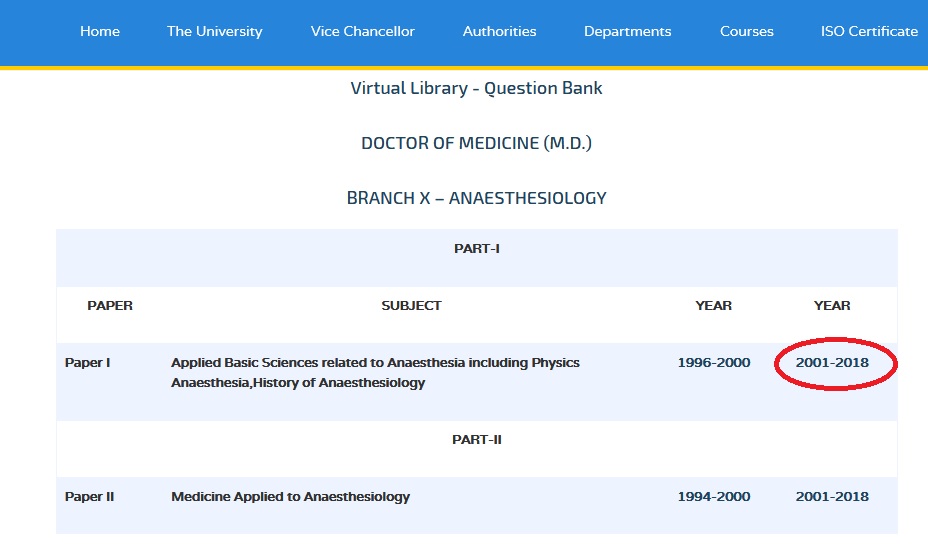Applied Basic Sciences Related to Anaesthesia Including Physics in Anaesthesia, History Of Anaesthesia MD Question Bank : web.tnmgrmu.ac.in
Name of the University : The Tamilnadu Dr. M.G.R. Medical University
Degree : Doctor of Medicine (M.D.)
Branch : Branch X – ANAESTHESIOLOGY
Subject Code/Name : 2040/Applied Basic Sciences Related To Anaesthesia Including Physics In Anaesthesia, History Of Anaesthesia
Paper : IV
Document Type : Question Bank
Website : web.tnmgrmu.ac.in
Download Model/Sample Question Paper :
1990-2000 : https://www.pdfquestion.in/uploads/web.tnmgrmu.ac.in/4295-1-202040KC.pdf
2001-2014 : https://www.pdfquestion.in/uploads/web.tnmgrmu.ac.in/4295-2-202040KX.pdf
TNMGRMU Basic Sciences Anaesthesia Question Paper
Sub. Code: 2040
M.D. DEGREE EXAMINATION
Branch X – ANAESTHESIOLOGY
(Common to all candidates)
APPLIED BASIC SCIENCES RELATED TO ANAESTHESIA INCLUDING PHYSICS IN ANAESTHESIA, HISTORY OF ANAESTHESIA
Related : Tamilnadu Dr. M.G.R. Medical University Physical & Organic Aspects of Biochemistry, Instrumentation MD Question Bank : www.pdfquestion.in/4298.html
March 2009
Q.P. Code : 202040
Time : Three hours
Maximum : 100 marks
Draw suitable diagram wherever necessary :
Answer ALL questions :
I. Essay questions : (2 x 20 = 40)
1. Describe how you would differentiate different types of neuromuscular blockade. Discuss the factors which modify neuromuscular blocking action of muscle relaxants.
2. Enumerate kidney function tests and their importance in anaesthesia.
II. Write short notes on : (10 x 6 = 60)
1. Hering – Bruer reflex.
2. Hyperkalemia.
3. Sir Robert Macintosh.
4. Functional residual capacity.
5. Low flow anaesthesia.
6. Heat and moisture exchanger.
7. Poiseuille’s Law.
8. Trans oesophageal echocardiography.
9. Milrinone.
10. Circle of Willis.

September 2009
I. Essay questions : (2 x 20 = 40)
1. Describe the anatomy and physiology of neuro muscular function. Discuss the methods of monitoring neuro muscular block.
2. Describe the principles of external defibrillators and its clinical uses. How is it different from automated external defibrillator.
II. Write short notes on : (10 x 6 = 60)
1. I and II Hyderabad chloroform commission.
2. James Young Simpson.
3. PIN Index System.
4. Uses and problems of anaesthetic data management system.
5. Capnography
6. Double lumen ET tubes.
7. Anaesthesia gas concentration monitors
8. Rigid largngoscope blades
9. Functional analysis of Bain’s circuit.
10. Gas plasma sterilization.
March 2010
I. Essay questions : (2 x 20 = 40)
1. Describe the anatomy of sympathetic nervous system and enumerate the functions.
2. Discuss the epidemiology and pathophysiology of anaphylaxis in anaesthesia practice. Describe the methods of identification, prevention and treatment.
II. Write short notes on : (10 x 6 = 60)
1. Hypermagnesemia.
2. Virgenia apgar.
3. Desflurane.
4. Placental barrier.
5. Hypoxic pulmonary vasoconstriction.
6. TEC 6 vaporizer.
7. Henry’s law.
8. Peripheral nerve stimulator.
9. Isoproterenol.
10. Cerebral steal syndrome.
April 2012
Sub. Code: 2040
I. Essay questions : (2 X 20 = 40)
1. Describe the Anatomy of the Brachial plexus; briefly describe the various types of brachial plexus blocks and describe in detail about any one block.
2. Describe in detail the various intravenous induction agents used in Anaesthesia.
II. Write short notes on : (10 X 6 = 60)
1. Cerebral circulation.
2. Coagulation Pathway.
3. Venturi Principle.
4. Hyderabad chloroform commission.
5. John Snow.
6. Hoffmann Elimination.
7. Oxygen Cascade.
8. Occulo Cardiac Reflex.
9. GABA receptor.
10. Reynolds number.
March 2009
[KU 144] Sub. Code: 2039
M.D. Degree Examination
Branch X – Anaesthesiology (Common to all candidates)
Medicine Applied To Anaesthesiology
Q.P. Code : 202039
Time : Three hours
Maximum : 100 marks
Draw suitable diagram wherever necessary
Answer ALL questions
I. Essay questions : (2 x 20 = 40)
1. Describe the pathophysiology of rheumatic valvular heart disease. Discuss in brief the cardiopulmonary bypass management of valvular replacement.
2. Anaesthetic management of posterior cranial fossa tumor.
II. Write short notes on : (10 x 6 = 60)
1. Anaesthetic consideration in electroconvulsive therapy.
2. Lung compliance.
3. Amniotic fluid embolism.
4. Soda bicarbonate.
5. Post-operative jaundice.
6. Neuro endocrine stress response.
7. TURP syndrome.
8. Pre-operative preparation in case of broncho pleural fistula.
9. Anaphylactic shock.
10. Temparo mandibular joint ankylosis.
September 2009
[KV 144] Sub. Code: 2039
M.D. Degree Examination
Branch X – Anaesthesiology (Common To All Candidates)
Medicine Applied To Anaesthesiology
Q.P. Code : 202039
Time : Three hours
Maximum : 100 marks
Draw suitable diagram wherever necessary
Answer ALL questions
I. Essay questions : (2 x 20 = 40)
1. Discuss the causes, diagnosis and management of cardiac dysrhythmias during anaesthetic practice.
2. Discuss the anaesthetic considerations and pathophysiology in obese patients.
II. Write short notes on : (10 x 6 = 60)
1. Thyroid storm
2. TURP syndrome
3. Diabetic ketoacidosis
4. Angiotensin receptor blockers
5. Preanaesthetic preparation of chronic smokers
6. Vasopressin in anaesthesia and ICU
7. Methods of airway assessment
8. Glassglow coma scale
9. End stage renal failure
10. Plasma volume expanders.